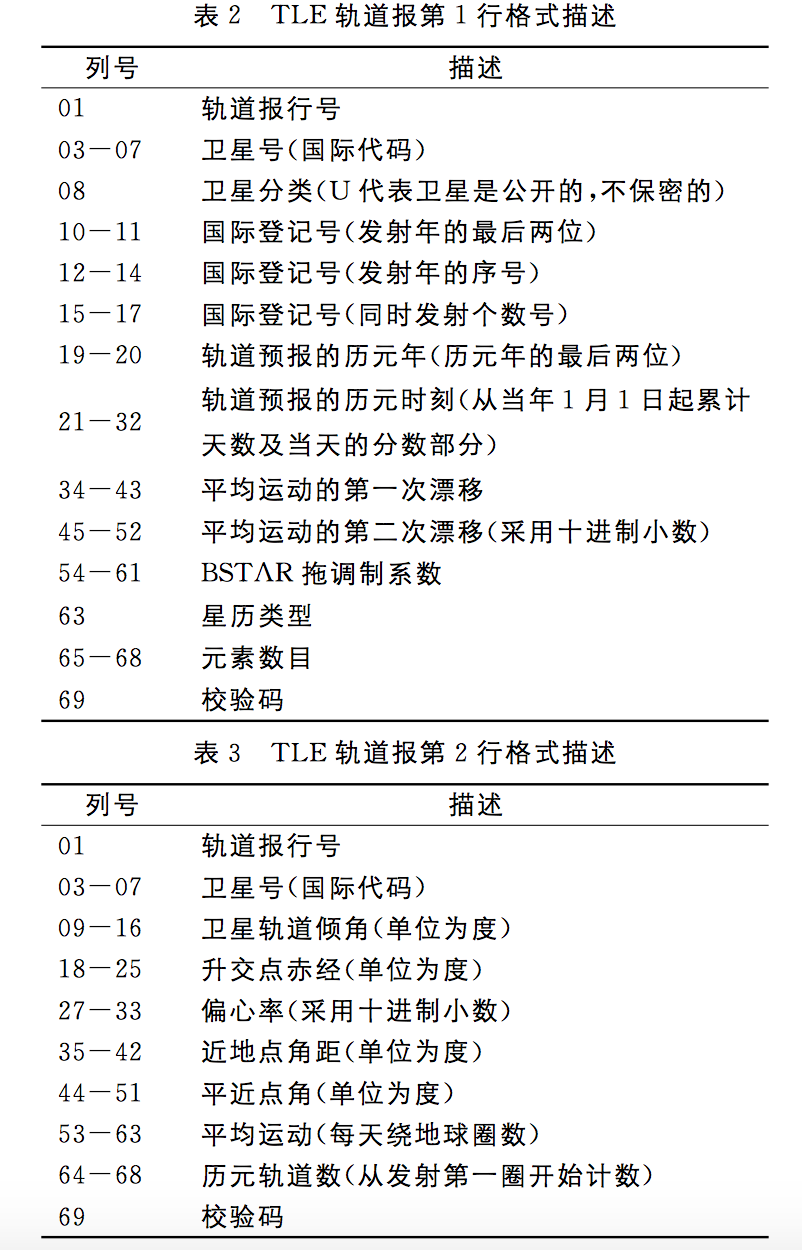开普勒元素通常以两行元素的格式发布。
它们有时被称为" TLEs " " Keps "
解释1:

解释2:
| 序号 | 栏 | 含义 | 说明和备注 |
| 0.1 | 01 | 目标名称 | 包含最多24个字符的字符串 |
| 1.1 | 01 | 行号 | 取值1 |
| 1.2 | 03-07 | 卫星编目号 | 5位十进制数表示,最多可编目99999个目标 |
| 1.3 | 08 | 卫星密级分类标识 | U表示非秘,S表示秘密(秘密目标根数不公开 |
| 1.4 | 10-11 |
卫星国际编号 |
发射年份,2位十进制数表示,如03代表2003年 |
| 1.5 | 12-14 | 年中序号,3位十进制数表示,如111表示当年的第111次发射 | |
| 1.6 | 15-17 | 本次发射中产生的目标序列,字符表示,如C表示本次发射中形成的第三个目标 | |
| 1.7 | 19-20 |
根数历元时刻 |
年份,2位十进制数表示,如03代表2003年 |
| 1.8 | 21-32 | 天数,年中的天数(年积日),小数点后保留8位有效数字(精确到1ms) | |
| 1.9 | 34-43 | 平运动一阶变率(1/2) | 单位为圈数/天 |
| 1.10 | 45-52 | 平运动二阶变率(1/6) | 单位为圈数/天,前6位为小数部分,后2位为指数部分,如-12345-6表示-0.12345×10 |
| 1.11 | 54-61 | 表示大气阻力的弹道系数:B*(=0.5CdS/M) | 单位为地球赤道半径的倒数,表示方法同1.10 |
| 1.12 | 63 | 定轨模型类型 | 内部使用,现在设为0,用SGP4和SDP4 |
| 1.13 | 65-68 | 根数组数 | |
| 1.14 | 69 | 检验位 | |
| 2.1 | 01 | 行号 | 取值2 |
| 2.2 | 03-07 | 卫星编目号 | 同1.2 |
| 2.3 | 09-16 | 轨道倾角 | 单位:度,小数点后4位 |
| 2.4 | 18-25 | 轨道升交点赤经 | 单位:度,小数点后4位 |
| 2.5 | 27-33 | 轨道偏心率 | 小数表示(1234567表示0.1234567),7位有效数字 |
| 2.6 | 35-42 | 近地点辐角 | 单位:度,小数点后4位 |
| 2.7 | 44-51 | 平近点角 | 单位:度,小数点后4位 |
| 2.8 | 53-63 | 平运动速度 | 单位:圈/天 |
| 2.9 | 64-68 | 相对于历元的圈数 | 单位:圈,发射后首次过升交点为第一圈, |
| 2.10 | 69 | 校验位 |
一组两行根数的例子:
DIAPASON (D1-A) 1 2016U 66013A 22040.47656371 .00000563 00000-0 15717-3 0 9990 2 2016 34.0968 195.3317 1186353 282.6277 64.4483 12.60172085539087
STARLINK-2452 1 48115U 21027Z 22040.12425648 .00004640 00000-0 33007-3 0 9991 2 48115 53.0563 8.5382 0001476 82.0419 278.0737 15.06410135 47642
....
参考:
Data for each satellite consists of three lines in the following format:
AAAAAAAAAAA 1 NNNNNU NNNNNAAA NNNNN.NNNNNNNN +.NNNNNNNN +NNNNN-N +NNNNN-N N NNNNN 2 NNNNN NNN.NNNN NNN.NNNN NNNNNNN NNN.NNNN NNN.NNNN NN.NNNNNNNNNNNNNN
Line1:
Column Description
01-01 Line Number of Element Data
03-07 Satellite Number
10-11 International Designator (Last two digits of launch year)
12-14 International Designator (Launch number of the year)
15-17 International Designator (Piece of launch)
19-20 Epoch Year (Last two digits of year)
21-32 Epoch (Day number and fractional portion of the day)
34-43 First Time Derivative of the Mean Motion divided by 2.
or Ballistic Coefficient (Depending of ephemeris type)
45-52 Second Time Derivative of Mean Motion divided by 6.
(Blank if N/A)
54-61 BSTAR drag term if GP4 general perturbation theory was used.
Otherwise, radiation pressure coefficient.
63-63 Ephemeris type
65-68 Element number
69-69 Check Sum (Modulo 10)
Line2:
Column Description 01-01 Line Number of Element Data 03-07 Satellite Number 09-16 Inclination [Degrees] 18-25 Right Ascension of the Ascending Node [Degrees] 27-33 Eccentricity (decimal point assumed) 35-42 Argument of Perigee [Degrees] 44-51 Mean Anomaly [Degrees] 53-63 Mean Motion [Revs per day] 64-68 Revolution number at epoch [Revs] 69-69 Check Sum (Modulo 10)
.
